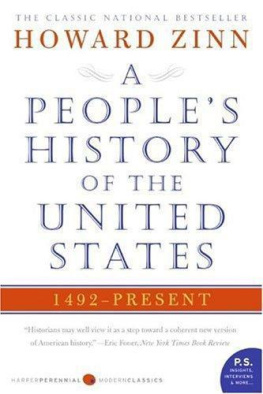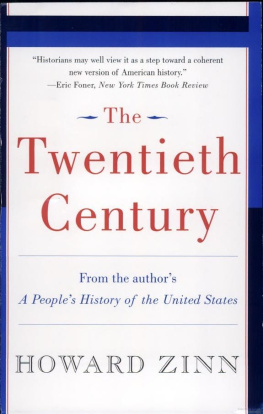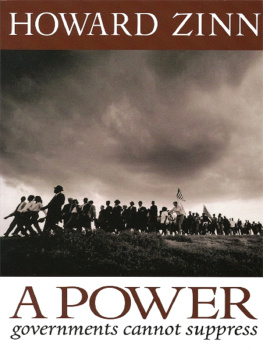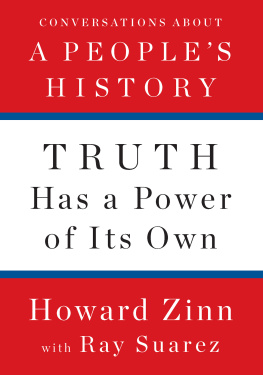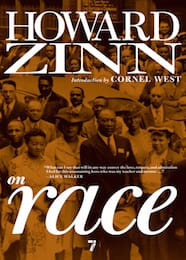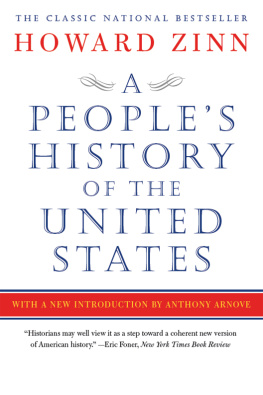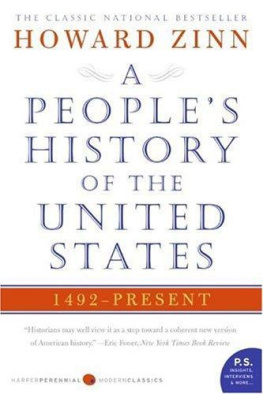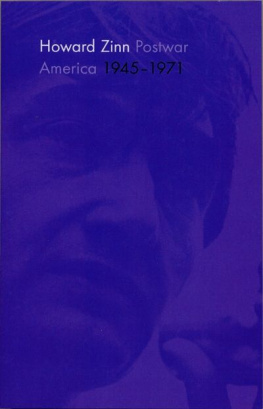Howard Zinn - A peoples history of the united states: 1492-Present
Here you can read online Howard Zinn - A peoples history of the united states: 1492-Present full text of the book (entire story) in english for free. Download pdf and epub, get meaning, cover and reviews about this ebook. City: Milton Park, Abingdon, Oxon, New York, NY,, year: 2013, publisher: Routledge;HarperCollins, genre: History. Description of the work, (preface) as well as reviews are available. Best literature library LitArk.com created for fans of good reading and offers a wide selection of genres:
Romance novel
Science fiction
Adventure
Detective
Science
History
Home and family
Prose
Art
Politics
Computer
Non-fiction
Religion
Business
Children
Humor
Choose a favorite category and find really read worthwhile books. Enjoy immersion in the world of imagination, feel the emotions of the characters or learn something new for yourself, make an fascinating discovery.
- Book:A peoples history of the united states: 1492-Present
- Author:
- Publisher:Routledge;HarperCollins
- Genre:
- Year:2013
- City:Milton Park, Abingdon, Oxon, New York, NY,
- Rating:3 / 5
- Favourites:Add to favourites
- Your mark:
- 60
- 1
- 2
- 3
- 4
- 5
A peoples history of the united states: 1492-Present: summary, description and annotation
We offer to read an annotation, description, summary or preface (depends on what the author of the book "A peoples history of the united states: 1492-Present" wrote himself). If you haven't found the necessary information about the book — write in the comments, we will try to find it.
Abstract: Presents the history of the United States from the point of view of those who were exploited in the name of American progress
A peoples history of the united states: 1492-Present — read online for free the complete book (whole text) full work
Below is the text of the book, divided by pages. System saving the place of the last page read, allows you to conveniently read the book "A peoples history of the united states: 1492-Present" online for free, without having to search again every time where you left off. Put a bookmark, and you can go to the page where you finished reading at any time.
Font size:
Interval:
Bookmark:
A Peoples History of the United States
A Peoples History of the United States
A Peoples History of the United States
A Peoples History of the United States
1492 to the Clinton presidency in 1996
By HOWARD ZINN
A Peoples History of the United States
1. Columbus, The Indians, and Human Progress
Arawak men and women, naked, tawny, and full of wonder, emerged from their villages onto the island's beaches and swam out to get a closer look at the strange big boat. When Columbus and his sailors came ashore, carrying swords, speaking oddly, the Arawaks ran to greet them, brought them food, water, gifts. He later wrote of this in his log: They ... brought us parrots and balls of cotton and spears and many other things, which they exchanged for the glass beads and hawks' bells. They willingly traded everything they owned.... They were well-built, with good bodies and handsome features.... They do not bear arms, and do not know them, for I showed them a sword, they took it by the edge and cut themselves out of ignorance. They have no iron. Their spears are made of cane.... They would make fine servants.... With fifty men we could subjugate them all and make them do whatever we want.
These Arawaks of the Bahama Islands were much like Indians on the mainland, who were remarkable (European observers were to say again and again) for their hospitality, their belief in sharing. These traits did not stand out in the Europe of the Renaissance, dominated as it was by the religion of popes, the government of kings, the frenzy for money that marked Western civilization and its first messenger to the Americas, Christopher Columbus.
Columbus wrote: As soon as I arrived in the Indies, on the first Island which I found, I took some of the natives by force in order that they might learn and might give me information of whatever there is in these parts.
The information that Columbus wanted most was: Where is the gold? He had persuaded the king and queen of Spain to finance an expedition to the lands, the wealth, he expected would be on the other side of the Atlantic-the Indies and Asia, gold and spices. For, like other informed people of his time, he knew the world was round and he could sail west in order to get to the Far East.
Spain was recently unified, one of the new modern nation-states, like France, England, and Portugal. Its population, mostly poor peasants, worked for the nobility, who were 2 percent of the population and owned 95 percent of the land. Spain had tied itself to the Catholic Church, expelled all the Jews, driven out the Moors. Like other states of the modern world, Spain sought gold, which was becoming the new mark of wealth, more useful than land because it could buy anything.
There was gold in Asia, it was thought, and certainly silks and spices, for Marco Polo and others had brought back marvelous things from their overland expeditions centuries before. Now that the Turks had conquered Constantinople and the eastern Mediterranean, and controlled the land routes to Asia, a sea route was needed. Portuguese sailors were working their way around the southern tip of Africa. Spain decided to gamble on a long sail across an unknown ocean.
In return for bringing back gold and spices, they promised Columbus 10 percent of the profits, governorship over new-found lands, and the fame that would go with a new tide: Admiral of the Ocean Sea. He was a merchant's clerk from the Italian city of Genoa, part-time weaver (the son of a skilled weaver), and expert sailor. He set out with three sailing ships, the largest of which was the Santa Maria, perhaps 100 feet long, and thirty-nine crew members.
Columbus would never have made it to Asia, which was thousands of miles farther away than he had calculated, imagining a smaller world. He would have been doomed by that great expanse of sea. But he was lucky. One-fourth of the way there he came upon an unknown, uncharted land that lay between Europe and Asia-the Americas. It was early October 1492, and thirty-three days since he and his crew had left the Canary Islands, off the Atlantic coast of Africa. Now they saw branches and sticks floating in the water. They saw flocks of birds.
These were signs of land. Then, on October 12, a sailor called Rodrigo saw the early morning moon shining on white sands, and cried out. It was an island in the Bahamas, the Caribbean sea. The first man to sight land was supposed to get a yearly pension of 10,000 maravedis for life, but Rodrigo never got it. Columbus claimed he had seen a light the evening before. He got the reward.
So, approaching land, they were met by the Arawak Indians, who swam out to greet them. The Arawaks lived in village communes, had a developed agriculture of corn, yams, cassava. They could spin and weave, but they had no horses or work animals. They had no iron, but they wore tiny gold ornaments in their ears.
This was to have enormous consequences: it led Columbus to take some of them aboard ship as prisoners because he insisted that they guide him to the source of the gold. He then sailed to what is now Cuba, then to Hispaniola (the island which today consists of Haiti and the Dominican Republic). There, bits of visible gold in the rivers, and a gold mask presented to Columbus by a local Indian chief, led to wild visions of gold fields.
On Hispaniola, out of timbers from the Santa Maria, which had run aground, Columbus built a fort, the first European military base in the Western Hemisphere. He called it Navidad (Christmas) and left thirty-nine crewmembers there, with instructions to find and store the gold. He took more Indian prisoners and put them aboard his two remaining ships. At one part of the island he got into a fight with Indians who refused to trade as many bows and arrows as he and his men wanted. Two were run through with swords and bled to death. Then the Nina and the Pinta set sail for the Azores and Spain. When the weather turned cold, the Indian prisoners began to die.
Columbus's report to the Court in Madrid was extravagant. He insisted he had reached Asia (it was Cuba) and an island off the coast of China (Hispaniola). His descriptions were part fact, part fiction: Hispaniola is a miracle. Mountains and hills, plains and pastures, are both fertile and beautiful ... the harbors are unbelievably good and there are many wide rivers of which the majority contain gold.... There are many spices, and great mines of gold and other metals....
The Indians, Columbus reported, are so naive and so free with their possessions that no one who has not witnessed them would believe it. When you ask for something they have, they never say no. To the contrary, they offer to share with anyone.... He concluded his report by asking for a little help from their Majesties, and in return he would bring them from his next voyage as much gold as they need ... and as many slaves as they ask. He was full of religious talk: Thus the eternal God, our Lord, gives victory to those who follow His way over apparent impossibilities.
Because of Columbus's exaggerated report and promises, his second expedition was given seventeen ships and more than twelve hundred men. The aim was clear: slaves and gold. They went from island to island in the Caribbean, taking Indians as captives. But as word spread of the Europeans' intent they found more and more empty villages. On Haiti, they found that the sailors left behind at Fort Navidad had been killed in a battle with the Indians, after they had roamed the island in gangs looking for gold, taking women and children as slaves for sex and labor.
Now, from his base on Haiti, Columbus sent expedition after expedition into the interior. They found no gold fields, but had to fill up the ships returning to Spain with some kind of dividend. In the year 1495, they went on a great slave raid, rounded up fifteen hundred Arawak men, women, and children, put them in pens guarded by Spaniards and dogs, then picked the five hundred best specimens to load onto ships. Of those five hundred, two hundred died en route. The rest arrived alive in Spain and were put up for sale by the archdeacon of the town, who reported that, although the slaves were naked as the day they were born, they showed no more embarrassment than animals. Columbus later wrote: Let us in the name of the Holy Trinity go on sending all the slaves that can be sold.
Next pageFont size:
Interval:
Bookmark:
Similar books «A peoples history of the united states: 1492-Present»
Look at similar books to A peoples history of the united states: 1492-Present. We have selected literature similar in name and meaning in the hope of providing readers with more options to find new, interesting, not yet read works.
Discussion, reviews of the book A peoples history of the united states: 1492-Present and just readers' own opinions. Leave your comments, write what you think about the work, its meaning or the main characters. Specify what exactly you liked and what you didn't like, and why you think so.

